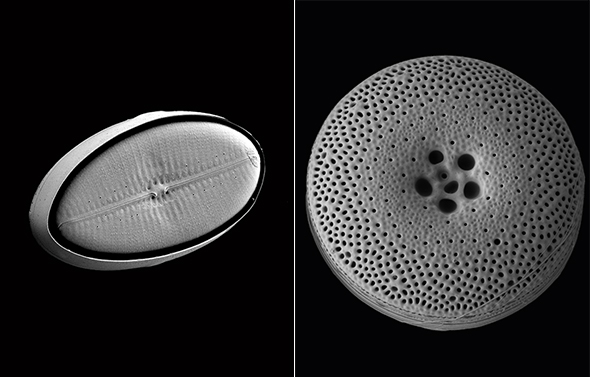Diatoms (Class Diatomophyceae/Bacillariophyceae) are predominantly unicellular organisms, although pseudofilamentous and colonial aggregations sometimes occur; their cell wall is composed of silica (SiO2) with an organic coating, and; they exhibit a wide variety of shapes and size, the latter ranging from about 2 µm to 5 mm in length. The fundamental nature of diatoms includes a sexual reproductive cycle, thus some cell features (e.g. size range, valve striation) may vary from data found in published literature.
Diatoms are important in the Southern Ocean as a major source of food for other trophic levels, particularly zooplankton, and as producers of the oxygen that is essential to life in the oceans. In addition, diatom community composition and abundance can be used to monitor short- and long term changes in the environment.
There are 197 species in our key and many can be identified solely by light microscopy (LM), however others require the use of a scanning electon microscope (SEM) to resolve cryptic features. Primarily we have used common or obvious characteristics such as ‘size’ and ‘shape’ of cells to separate species. Morphological details observed at LM or SEM level (e.g. valve ornamentation, areolation, processes) are then used to further narrow your results. A thumbnail image of each species is included as a “first impression” and this, in some cases, can lead directly to a successful identification. Further images can be viewed on the factsheets. Images are sourced from Antarctic Marine Protists (eds. Scott & Marchant, 2005) unless otherwise credited. A glossary to explain specific terms has been integrated into both key and factsheets.
Related Links
Taxonomic names are those used in ‘AlgaeBase’ (accessed April 2013). The following references and weblinks may be useful to the user:
- AlgaeBase
- Marine Phytoplankton Lab Gallery
- Census of Australian Marine Diatoms (ABRS)
- International Society for Diatom Research
- Catalogue of Diatom Names (California Academy of Sciences)
- Index Nominum Algarum Bibliographia Phycologica Universalis
References
- Hasle, G.R. & Syvertsen, E.E. (1997), Marine diatoms. In Tomas, C.R. (ed.), Identifying Marine Diatoms and Dinoflagellates. (Academic Press, San Diego). pp. 5–385.
- Medlin, L.K. & Priddle, J. (eds) (1990), Marine Polar Diatoms. (British Antarctic Survey, Cambridge).
- Round, F.E., Crawford, R.M. & Mann, D.G. (1990), The Diatoms. Biology and Morphology of the Genera. (Cambridge University Press, Cambridge).
- Scott,F.J.& Marchant, H.M. (eds) (2005), Antarctic Marine Protists (ABRS & AAD, Canberra).
